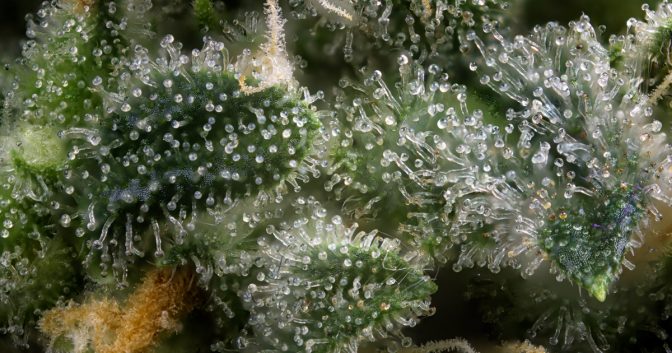Passing the Smell Test: What You Need to Know About Terpenes

“Terpenes” is a new term in the cannabis glossary. They provide the smells and tastes in pot and are responsible for a wide range of medical effects
Terpenes are aromatic molecules secreted inside the tiny resin glands of the flowers or buds. They produce a citrusy aroma in some strains and may smell and taste like lavender or even cheese in others.
There are at least 100 terpenes unique to the cannabis plant; the combination of these chemicals and cannabinoids is what creates such effects as being sleepy or energetic.
The term terpene is also often used to refer to terpenoids, which are oxygenated derivatives of terpenes.
Terpenes play a major role in resin development and are heavily used in the production of essential oils for medical and beauty products. That’s how terpenes made their way into the fragrance industry, as well as conventional and alternative medicine. They’re most commonly used in aromatherapy, but are also synthetically made as flavors and aromas and as food additives.
Terpenes coexist with cannabinoids like THC and CBD, but are not psychoactive like THC. They interact with the body’s endocannabinoid system and assist cannabinoids in entering the bloodstream.
Here are the Top 10 terps:

1. Myrcene
It’s the most abundant terpene in cannabis. A 1997 Swiss study indicated that myrcene could be as much as 65% of the total terpenes in some strains. Its smell often has earthy, musky notes, resembling cloves, as well as a fruity aroma like red grapes. Strains that contain more than 0.5% of this terpene are usuallyindicas with sedative effects, which is good for insomnia. Myrcene is also useful in reducing inflammation and chronic pain, which is why it’s recommended as a supplement during cancer treatments.
Strains: Skunk XL, Special Kush, White Widow
Bonus tip: If you want to experience a stronger buzz from marijuana, eat a mango about 45 minutes before smoking or vaping. Mangoes contain significant amounts of myrcene, so eating one will strengthen the effects of THC by increasing its absorption rate.

2. Limonene
It’s the second most abundant terpene in pot, but not all strains necessarily have it. Limonene gives strains a citrusy smell that resembles lemons (all citrus fruits contain large amounts of it). It’s commonly used in cosmetics and cleaning products. Limonene improves mood and reduces stress, has antifungal and antibacterial properties, and may have a role in reducing tumor size. Sativa strains that have “lemon” or “sour” in their names are usually rich in limonene.
Strains: Durban Poison, Jack Herer, Jack the Ripper, O.G. Kush, Sour Diesel, Super Lemon Haze
 3. Linalool
3. Linalool
This terpene is mostly responsible for marijuana’s typical smell with its spicy, floral notes. Linalool is also found in lavender, mint, cinnamon and coriander. Like those aromatic herbs, it has strong sedative and relaxing properties. Patients suffering from anxiety, depression, seizures and insomnia should benefit from this powerful terpene.
Strains: Amnesia Haze, LA Confidential, Lavender, OG Shark, Special Kush
 4. b-Caryophyllene
4. b-Caryophyllene
Best known for its spicy and peppery notes, b-caryophyllene is also found in black pepper, cinnamon, cloves and spices such as oregano, basil and rosemary. Since it binds to CB2 receptors (it’s the only terpene that binds to cannabinoid receptors), b-caryophyllene is commonly found in anti-inflammatory topicals and creams. Besides its analgesic and anti-anxiety properties, some believe it helps people trying to quit using alcohol.
Strains: Rock Star, Super Silver Haze, Skywalker
 5. a-Pinene and b-Pinene
5. a-Pinene and b-Pinene
These two terpenes smell like pine trees, where they can be found in large amounts. Other plants rich in pinene include rosemary, orange peels, basil and parsley. Pinenes have anti-inflammatory effects. They help improve airflow and respiratory functions (for asthmatics) as well as memory, and can be beneficial those suffering from arthritis, Crohn’s disease and cancer.
Strains: Blue Dream, Dutch Treat, Island Sweet Skunk, Jack Herer, Romulan, Strawberry Cough
 6. a-Bisabolol
6. a-Bisabolol
Also known as levomenol and bisabolol, a-bisabolol has a pleasant floral aroma and can also be found in chamomile flowers and candeia trees. This terpene has been primarily used in the cosmetics industry, but lately has caught the attention of researchers since it can be used to treat bacterial infections and wounds. It’s also an antioxidant with anti-irritation and analgesic properties.
Strains: ACDC, Harle-Tsu, Headband, OG Shark, Pink Kush
 7. Eucalyptol
7. Eucalyptol
Also known as cineole, eucalyptol is the primary terpene of the eucalyptus tree. It has a recognizable minty smell, but most cannabis strains don’t contain much of it. It’s mostly used in cosmetics. Eucalyptol relieves pain and slows the growth of bacteria and fungi. Although research is still in the early stages, it has shown some promising effects on Alzheimer’s patients.
Strains: Headband, Super Silver Haze
 8. Nerolidol
8. Nerolidol
Found mostly in flowers like jasmine and lemongrass, nerolidol smells like a mixture of rose, citrus and apples. It’s woody, citrusy and floral. This terpene is best known for its antiparasitic, antioxidant, antifungal, antimicrobial and sedative properties.
Strains: Island Sweet Skunk, Jack Herer, Skywalker OG
 9. Humulene
9. Humulene
It’s found in hops, clove, sage and black pepper and has an earthy, woody and spicy aroma. Humulene suppresses appetite (good for dieters), reduces inflammation, relieves pain, fights off bacterial infections and may prevent cancer cells from growing.
Strains: Girl Scout Cookies, Headband, Sour Diesel, Pink Kush, Skywalker OG, White Widow
 10. Carene
10. Carene
Also found in rosemary, basil, bell peppers, cedar and pine, it has a sweet aroma reminiscent of cypress trees. Carene helps heal broken bones, which gives hope to patients suffering from osteoporosis, arthritis and even fibromyalgia. It also promotes memory retention, which could be useful for Alzheimer’s patients.
Strains: Skunk #1, Super Lemon Haze, Super Silver Haze
Related Articles
Debunking Indica and Sativa: What You Really Need to Know About Marijuana
Seven Steps to Having a Successful Outdoor Cannabis Garden
Book Review: «The Leafly Guide to Cannabis»
This is an abridged version of an article previously published at greencamp.com. If you enjoyed this Freedom Leaf article, subscribe to the magazine today!
